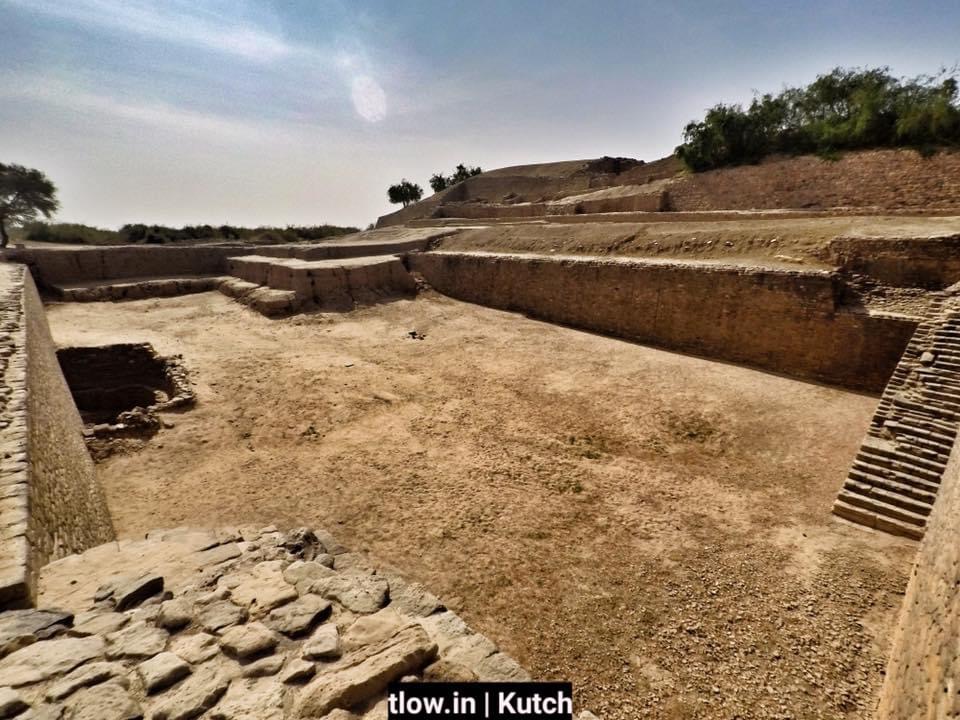
The forgotten Harappan civilization : Dholavira, Gujarat
Dholavira is the site of the world-famous Harappan civilization which is located deep inside the island of Khadir, amidst the salt plains of the Great Rann of Kutch in Gujarat. Dholavira is one of the five largest Harappan sites in the world and the most prominent archaeological site in India belonging to the Indus Valley Civilization.
Travellers have multiple options to reach Dholavira. The first option is to hire a private vehicle from Bhuj and drive down to the archaeological site. The city of Bhuj is located around 250 kms from Dholavira and the journey by car takes around four to five hours one way. If you plan on doing a day trip it is advisable to leave early in the morning with breakfast enroute.

The second option is to board the government buses which leave from Bhuj at 2 pm and arrives at Dholavira at 8 pm. The bus leaves at 5 am the next morning and returns to Bhuj by 11:30 am. The bus journey is long but at the same time much lighter on the pocket.
Dholavira
was discovered in the year 1967 and is the fifth largest of eight major Harappan sites and has been under excavation since 1990 by the Archaeological Survey of India (ASI). But sadly due to lack of adequate funding, the excavation has been frozen for the last 10 years.

The excavation brought to light the urban planning and architecture, as well as unearthed large numbers of antiques such as seals, beads, animal bones, gold, silver, terracotta ornaments, pottery and bronze vessels. Archaeologists claim that Dholavira was an important centre of trade between settlements in south Gujarat, Sindh and Punjab as well as parts of Western Asia.
This ancient city was constructed to a pre-existing geometrical plan consisting of three divisions – the citadel, the middle town, and the lower town. The middle town had been furnished with their own defense-work, gateways, built-up areas, street system, wells and large open spaces.

The only way to get a real understanding of the place is by hiring a guide from within the complex. Guides are easily available and explain the entire site to the bone detail. The guided tour takes around a couple of hours and the cost of the guide is negligible as compared to the knowledge they share about the excavation. Nearly all the guides were an active part of the excavation and spent many years helping the ASI.
The guides generally start the tour by first giving travellers a brief description about the place and then take travellers through the various stages of excavation which includes the reservoirs. After passing through the reservoir complex, one will notice a huge circular structure on the site, which is believed to be a grave or memorial. However, it contained no skeletons or other human remains.

The structure consists of ten radial mud-brick walls built in the shape of a spoke wheel. A soft sandstone sculpture of a male with phallus erect, head and feet below ankle truncated was found in the passageway of the eastern gate.
Without a guide, Dholavira is just a barren piece of land to the average traveller and will feel like an abandoned graveyard. Most of the guides can only explain in Hindi and Gujarati. There is also a museum at the entrance near the parking lot which showcases a giant bronze hammer, a big chisel, a bronze hand-held mirror, shell bangles, phallus-like symbols of stone, square seals with Indus inscriptions and signs, a circular seal, dish-on-stand, perforated jars, terracotta tumblers, architectural members made of ballast stones, grinding stones, mortars, etc which were also found at this site.

Accommodation near Dholavira is limited to only a couple of traditional mud cottage complexes, one which is run by the government and the other being private. The government rest house is a 10-minute walk from the site and has both air-condition and non-air-condition cottages. Since there are only two staying options, the cost of the rooms is pretty steep and fluctuates based on demand.
The best option for food at Dholavira is to have it arranged by the guide who will arrange for some mouth-watering Gujarati home cooked thalis. The vegetarian thali generally consists of rice, dal, a couple of vegetables and roti. The food is very simple and basic but at the same time, it is a saving grace in the middle of nowhere.

While travelling to Dholavira, one must keep in mind that there are no ATM machines beyond the town of Rapar and hence carry enough cash. Cell phone coverage is also not the greatest around the site.
Dholavira is a must-visit while on a trip to the Great Rann of Kutch because it’s not always that you get to visit and walk through one of the oldest and grandest civilization in the country and the world. A day trip from Bhuj is enough to explore the entire site and even though it makes for a hectic journey it’s still better than staying at Rapar (the closest town) or near Dholavira.
–>For a similar experience, >>Click here












A real wonder which is forgotten
A must visit when in Bhuj
Defiantly a place with will bring back your history class to mind.
A place only for the history lovers.
The best blog that has come up on my research.
This place is far but definitely worth the travel time.
Save a day extra while in Kutch and visit this ancient ruin site.
Make sure you take a local guide to understand this lost city.
You need a whole day to experience the ruins
Avoid going here during the monsoon at all cost.
The local home made thail is a treat after walking in the sun for half a day
A place Derain,y lost in time.
A must visit for history freaks.
The step wells are so well built.